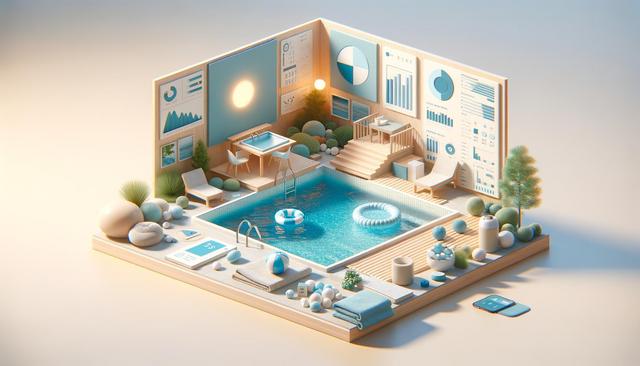Understand the Site Requirements
Before committing to a fiberglass pool, it’s essential to evaluate your property’s suitability. Not every backyard is automatically ready for a pool installation, especially when dealing with fiberglass shells that arrive pre-formed. One of the first steps is to inspect the ground conditions. Clay-heavy soil, sloped terrain, or high water tables could require additional groundwork and preparation. These factors might influence the project’s timeline and budget. In some cases, excavation might reveal the need for retaining walls or soil stabilization techniques.
Additionally, consider any local zoning laws or HOA regulations that may restrict pool installations. Permits are often required, and setback limitations from property lines or existing structures could affect your design options. Homeowners should also factor in access for heavy equipment needed during delivery and installation, as fiberglass pools are delivered in one piece.
Key site-related questions to ask include:
- Is there enough space for the pool and surrounding deck?
- Are there utility lines underground or overhead?
- Will the installation affect existing landscaping or irrigation systems?
Taking time to assess your site thoroughly ensures a smoother installation process and helps avoid unexpected costs.
Choose the Right Pool Design
Fiberglass pools come in various shapes, sizes, and finishes. Unlike concrete pools that are fully customizable, fiberglass pools are limited to pre-molded options. Therefore, choosing the right design upfront is crucial to meet your long-term needs. Consider how you intend to use the pool—whether for exercise, family recreation, or simply as a decorative feature.
Some popular design elements to consider include:
- Integrated steps and benches for easy access and seating
- Built-in tanning ledges or shallow areas for lounging
- Deep-end options for diving (within safety guidelines)
The color and finish of the pool’s interior can also impact the overall aesthetic. Modern fiberglass finishes offer a wide range of hues and textures, from classic blue to contemporary gray tones. Make sure the design aligns with your home’s architecture and landscape to create a cohesive outdoor space.
Also, think about future add-ons, such as water features, lighting, or heating systems. Selecting a design that accommodates these upgrades can make future enhancements easier and more cost-effective.
Evaluate Installation Timelines and Seasons
One of the benefits of fiberglass pools is the relatively fast installation compared to other pool types. However, several factors can influence the timeline. Weather, contractor availability, and permit approval processes can all contribute to delays. Typically, the installation process spans from a few days to a few weeks, depending on the complexity of the project.
Planning your installation during favorable weather seasons can help avoid unnecessary setbacks. Spring and early summer are popular times for pool installations, but scheduling during the off-season might offer better contractor availability and pricing. Be prepared for some level of disruption in your yard, as excavation and heavy equipment movement are involved.
To ensure a smooth timeline:
- Start planning and gathering quotes months in advance
- Confirm permit requirements early with local authorities
- Discuss realistic timelines with your contractor based on seasonal factors
Having a flexible schedule and a realistic understanding of the process helps manage expectations and reduces stress during installation.
Consider Long-Term Maintenance and Durability
Fiberglass pools are known for their durability and relatively low maintenance. Unlike concrete pools that may require resurfacing or frequent chemical adjustments, fiberglass surfaces are non-porous and resistant to algae growth. However, maintenance is still necessary to keep your pool in top condition over the years.
Routine tasks include:
- Skimming debris and vacuuming the pool floor
- Maintaining proper chemical balance
- Inspecting the filtration and pump systems
Fiberglass shells are designed to be long-lasting, but it’s important to avoid sharp objects or excessive impact that could damage the surface. Additionally, proper water chemistry is crucial to prevent staining or fading of the gelcoat finish. Investing in a quality pool cover can also help reduce maintenance by keeping out leaves and protecting the surface during colder months.
Understanding your responsibilities as a pool owner ensures that your investment remains functional and visually appealing for years to come.
Budgeting and Financing Options
Installing a fiberglass pool involves various costs beyond the pool itself. Homeowners should consider the total project budget, which includes excavation, electrical work, plumbing, decking, landscaping, and optional features like heating or lighting. While fiberglass pools can have lower lifetime maintenance costs, the upfront investment can still be significant.
To manage your budget effectively:
- Request detailed quotes from multiple contractors
- Ask about included warranties and service packages
- Plan for unexpected expenses or upgrades
Some homeowners explore financing options to spread out the cost over time. Pool loans, home equity lines of credit, or personal loans are commonly used to fund pool installations. Be sure to review interest rates, repayment terms, and total loan costs to make an informed decision.
Also, consider the long-term value a pool can add to your property. While it may not recoup the full investment in resale, it can enhance your outdoor living experience and increase buyer interest if you decide to sell in the future.
Final Thoughts: Making an Informed Decision
Adding a fiberglass pool to your property is a rewarding decision when approached with careful planning and realistic expectations. By evaluating your site, selecting a design that fits your lifestyle, understanding installation timelines, preparing for maintenance, and budgeting wisely, you can create a space that brings enjoyment for years to come. Taking these steps ensures that your fiberglass pool project is not only a visual upgrade but also a functional and lasting addition to your home.






